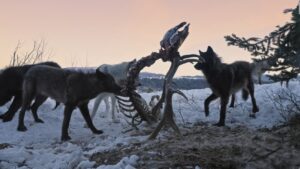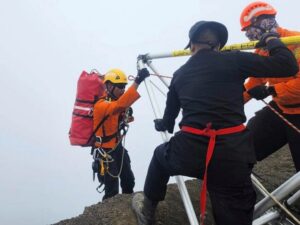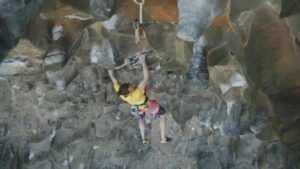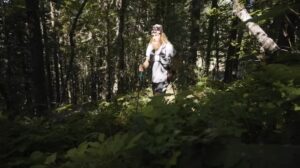There’s a lot that’s enticing about Fire of Love. A portrait of two oddballs, thrown together in die-hard love; a tragic, shared annihilation; and lots of 8mm footage of volcanic eruptions.
Ultimately, it’s the final item on that list you’ll want to be here for.
The film opens as our co-protagonists, Maurice and Katia Krafft, struggle to guide a perhaps overmatched vehicle through a hammering snowstorm. There aren’t roads. Slush bogs them down. When they reach their apparent destination, it’s an unimpressive scab of volcanic rock jutting out of the snow. The two scientists get out of the car and start walking around without speaking.
Then the voiceover cuts into the silence. The film’s action often labors under the heavy hand of that narration, performed by Miranda July.
“In love, you fall hard for what you know; harder for what you don’t,” she states portentously. “What makes the earth’s heart beat, its blood flow? Understanding is love’s other name,” she pronounces elsewhere.

Maurice and Katia Krafft. Photo: YouTube screenshot
While I wouldn’t call National Geographic’s spin on the movie — “a love story of two volcanologists who died as explosively as they lived” — unfair, the narrative doesn’t do their shared passion for volcanoes any favors. Mainly, we never really get to know the couple themselves.
It is so much easier to watch the action on the screen and interpret their relationship based on observation. One thing’s clear: Maurice and Katia Krafft were devoted students of a spectacular field.
The documentary sets up volcanology as a renegade science, back when the Kraffts practiced it in the 1970s and ’80s. At the time, unpredictable eruptions of global significance punctuated a field still in its infancy. In fact, the Kraffts’ tenure coincided with the widespread adoption of the theory of plate tectonics.
Just add early video cameras, Jacques Cousteau-style spots on television, and enough grant money to get by, and the Kraffts became scientific celebrities, at least in Europe. Eventually, the two eccentrics evolved into polished performers, adeptly playing a version of themselves.
But their footage is the real celebrity in this film. Their flirtation with flowing lava and unpredictable volcanic bombs is so intimate, their filming so excellent, that 40 years of technological improvements in video production have not diminished the impact of their work.
There’s no point in describing these scenes. Two individuals stand as close as humanly possible to rivers or fountains of molten, boiling rock.

The Kraffts. Photo: YouTube screenshot
Fire of Love tries to illustrate what drew the couple toward those places, and toward each other, but that second part of the narrative often feels strained.
I’ll give the writers a break because I think a big reason why the love story isn’t more convincing is that the Kraffts themselves are inscrutable. As public figures tend to do, they shielded their real selves and cultivated personas — in this case, as two eccentric researchers walking around in tinfoil suits and frying eggs on boiling rock. But who were they, really? What lay behind this couple who seemed only to relate to each other in terms of volcanoes?
I never learned through the movie, but the footage kept me so consistently enthralled that I didn’t mind some narrative clumsiness. What the film inevitably revealed about their relationship was a story of two individuals becoming increasingly engrossed by dangerous energy. Enabling each other, they drew ever closer to it.
Undercurrents grow troubling, and obsessive tendencies intrude. At one point, the narration lines up with what the viewer begins to sense is a disturbing trend in the Kraffts’ methodology.
“The closer they get, the more they see.”
Every addict has entertained this fallacy.

Photo: YouTube screenshot
The tension builds. Eventually, the “red” volcanoes that they classify as relatively safe are not enough for them. The Kraffts begin to flirt with the most dangerous volcanoes, the “grey” ones.
At that point, the film begins to foreshadow death. Mount St. Helens erupts. And the two generally proceed toward life’s final destination.
The eruptions grow more horrendous, animal death surfaces as a subtopic, and Katia “questions her life’s purpose for the first time.”
But then again, maybe that’s how it goes. To truly live is to risk it all. We’ll never get out of this world alive, anyway.
What that says about love and volcanoes, I don’t know. Do I have to? I’d rather just watch red-hot lava bubble, flow, and churn through its roiling existence. Ultimately it will resolve itself as solid rock, from which new life will eventually spring.
Fire of Love is currently streaming on Disney+.





